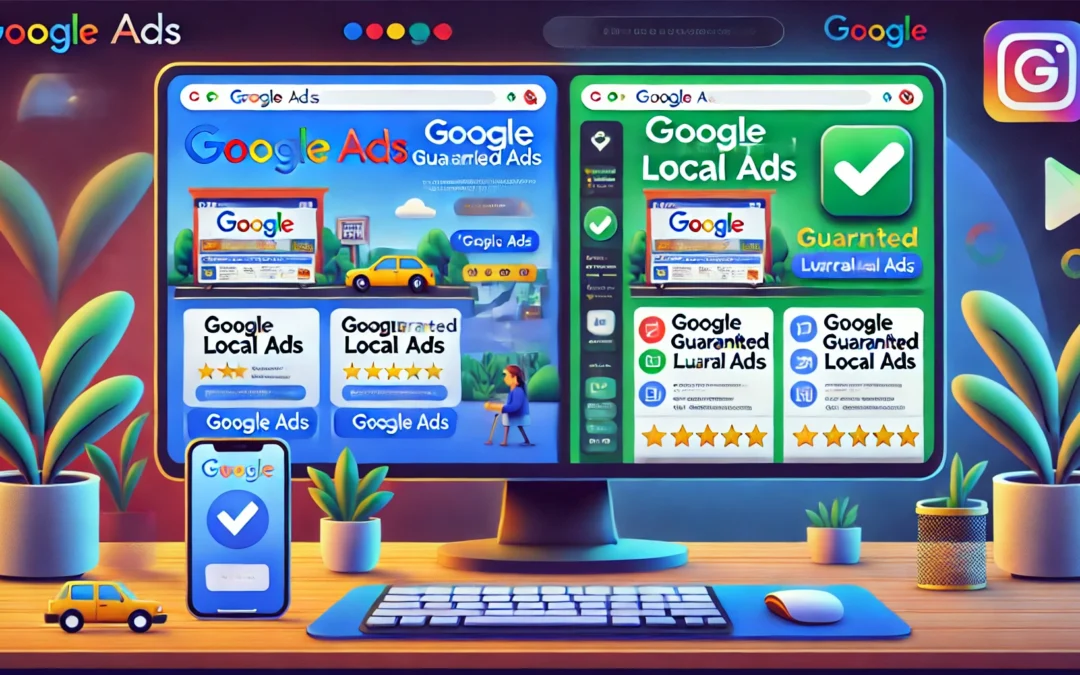When working with a limited marketing budget, choosing the right advertising platform is critical. Many businesses face a common dilemma: should they invest in Google Ads (PPC) or Google Local Services Ads (LSAs)? While both can generate leads, they cater to different types of businesses and have unique cost structures. In this guide, we’ll break down the key differences, the pros and cons of each, and how to determine which one is the best investment for your business.
1. Google Ads vs. Google Local Services Ads: What’s the Difference?
Before diving into which one is the better choice, let’s break down their fundamental differences:
Google Ads (PPC)
- Uses a keyword-based bidding system where businesses pay per click.
- Offers extensive audience targeting, including demographics, interests, and location.
- Ads appear in search results, YouTube, and Display Network placements.
- Provides more flexibility for campaign optimization and budget control.
Google Local Services Ads (LSAs)
- Operates on a pay-per-lead model rather than per click.
- Focused on local service businesses (e.g., plumbers, locksmiths, electricians, HVAC, etc.).
- Appears above Google Ads and organic search results, increasing visibility.
- Features the Google Guaranteed badge, building trust with potential customers.
- Allows businesses to receive calls even when the ad isn’t actively running, thanks to the Google Guaranteed icon.
Knowing these distinctions, let’s explore when each option makes the most sense for your budget and goals.
2. When Google Ads is the Better Choice
Google Ads is ideal for businesses that need a scalable, flexible, and strategic approach to advertising. It works best for:
- Businesses with a broader audience (e.g., e-commerce, SaaS, national brands).
- Companies looking to drive traffic to their website and generate conversions.
- Those who want detailed control over their ad spend, bidding, and targeting.
- Businesses focusing on long-term brand awareness and scalability.
Cost Breakdown
Google Ads follows a cost-per-click (CPC) model, meaning you pay every time someone clicks your ad.
- Costs vary by industry, ranging from $1 to $50+ per click depending on competition.
- Requires an optimized landing page to convert traffic into leads or sales.
- A well-managed PPC campaign can yield a strong return on investment when optimized properly.
3. When Google Local Services Ads is the Better Choice
Google LSAs are designed for businesses that rely on local service-based customers. These ads work well for:
- Home services like plumbing, HVAC, locksmiths, and electricians.
- Businesses that need immediate leads rather than long-term brand-building.
- Companies looking for a pay-per-lead model rather than pay-per-click.
- Local businesses that want to appear at the very top of search results.
- Businesses that can benefit from receiving calls even when the ad isn’t actively running, as the Google Guaranteed badge helps maintain visibility and credibility.
Cost Breakdown
Unlike PPC, LSAs charge per lead rather than per click.
- Costs range from $15 to $100+ per lead, depending on the industry.
- Google qualifies leads, meaning businesses only pay for valid customer inquiries.
- Leads go directly to the business via phone call or message, bypassing the need for a landing page.
4. Making the Decision: Which One to Choose on a Limited Budget?
If your budget only allows for one, here’s how to determine the best option:
Choose Google Ads If:
✔ You need a scalable solution with potential for long-term ROI. ✔ Your business operates beyond local service areas (e.g., national e-commerce, digital services). ✔ You want more flexibility in targeting and campaign optimization. ✔ Your business thrives on website visits and online sales.
Choose Google Local Services Ads If:
✔ You rely on local leads and phone calls to drive business. ✔ Your business is service-based (e.g., HVAC, plumbing, electricians, home services). ✔ You need immediate visibility at the top of Google Search. ✔ You prefer a pay-per-lead model rather than paying per click. ✔ You want to receive calls even when your ad isn’t actively running, leveraging the Google Guaranteed icon to stay visible.
How to Decide Based on Cost Per Lead vs. Cost Per Click
- If your industry has high PPC costs ($20+ per click) and your website doesn’t convert well, LSAs might be the better option.
- If your business can turn website traffic into high-value sales, PPC offers longer-term benefits.
- Testing both with a small budget can help identify which brings the best ROI.
5. Final Takeaway: Smart Spending for Maximum ROI
There is no one-size-fits-all answer, but the key is aligning your budget with your business model and goals. If you need immediate, high-intent leads, LSAs are often the better bet. If you want scalability, broader targeting, and website-driven conversions, Google Ads is the stronger choice.
Key Action Steps:
- Analyze your industry’s average Cost Per Click vs. Cost Per Lead.
- Determine if your business model thrives on immediate leads or long-term traffic.
- Test a small campaign on both platforms to see which generates better results.
- Optimize and scale based on real-world data.
